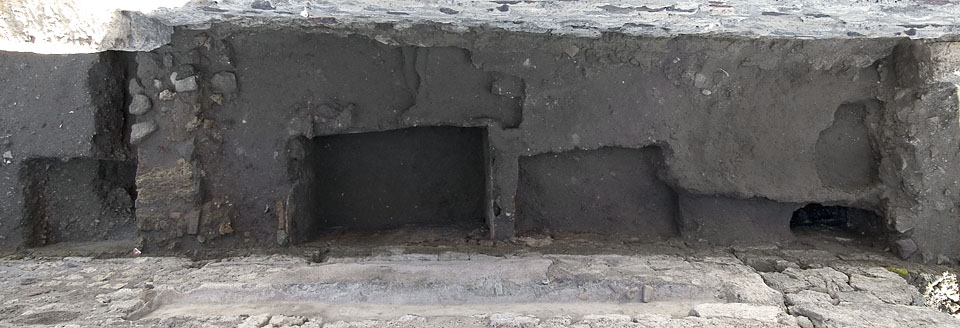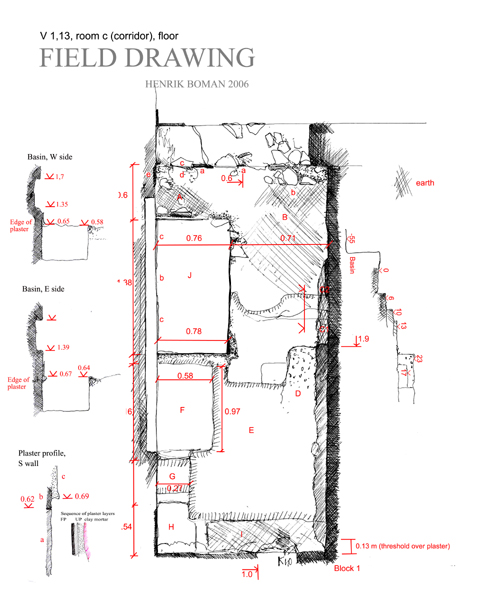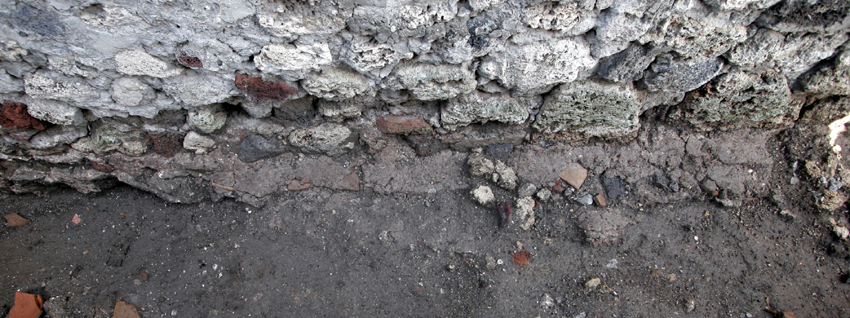Floor
Description
Henrik Boman & Monika Nilsson
The floor in the corridor was heavily destroyed, with only few traces still visible along the walls. The floor slopes upwards to room d which is situated on a higher level.
During the cleaning of the floor in the corridor, several new features were discovered. A basin sunk into the floor (J) had been filled-in with debris in antiquity. Walls were found below floor level, extending across the door opening to room a as well as into room d.
A larger sondage was made along the south wall, where plaster and earlier building activity in the building might have been detected.
The floor was divided into several areas see ’Details’), including the basin (J), the earlier floor (C1-C2), and the sondage areas (F, G, H).
It is not possible to see if the plaster continues behind the N wall of the corridor, though the depth of the plaster (in H) continued below floor level and indicates that there had been some kind of arrangement of the room before the present layout.
Several findings in the corridor points to the earlier layout of the house. The floor level found in the basin (J) are presumably the remains of the earliest phase of the building. The E wall could have been cut down for the rearrangements of the house for the present layout, a building phase most likely connected to the E wall of room a and the closed door in room b.
The floor was divided into 8 areas, including the basin (J), the earlier floor (C1-C2) and the sondage areas (F, G, H).
Area A: The area between the W wall - discovered under floor level and originally closing c to room a - and the basin, with earth and floor fragments blended. Earth mortar (d) and stones are lying towards the wall. There is no clear structure in the material, but it is very hard in texture.
There are no traces of a constructed supporting wall of the basin here, and therefore we assume that the basin had been lowered into the floor of the corridor.
W wall: Plaster found below floor level on the E surface of the W wall (a), continues for c. 0.6m from the S wall. A brick/tile (c) extends over the line of the wall plaster (a), showing that the wall presumably was cut down and then used as foundation for the threshold. The cut-down wall consists of at least one large ashlar, c. 0.6m in length, c. 0.4m in width and of unknown depth. In the SW corner, the plaster on the south wall (e) abuts the plaster on the W wall (a), signifying a plastered corner. No plaster is visible north of the large stone block.
A line in the stone, presumably beddings for the now destroyed floor by (b), runs parallel to the W wall (below the threshold).
Area B: Surface with material blended with earth, soft in character, and no traces of a floor preserved.
Area C1-C2, Floor: The remains of a cocciopesto floor, most certainly the floor of AD 79. Along parts of the N wall, it abuts to the wall in a steep angle, adopting to the stone work of the wall - there are no imprints or remains of any plaster on the wall. This could be a rough bedding for a now destroyed floor.
The material is light pink (similar to the material by the conduit in room d) and contains fragments of terracotta and stone (lava and limestone). Between areas C1 and C2 the colour seems to shift, c. 1.9m from W wall. C2 is somewhat browner in tone, and it is applied above C1 and upon the wall.
Area D: A layer, c. 1.5 cm thick, with pinkish colour as in area C. An edge towards C is visible, though it is presumably the same material and same floor structure.
Area E: An area with substantial amounts of earth and in level located under the floor remains (C1-C2, D). Along the south wall are the findings in this area similar to those found in the basin (J).
Area F: Examination was carried out c. 0.3m under floor level (C1-C2) along the S wall. As on the west side, there is no supporting wall for the basin, confirming the assumption of a basin sunken into the floor. The character of the finds are similar to the finds in the basin (J).
Area G: In the same sondage along the S wall, at lower level than F, with the same material character as F.
Area H: A deeper investigation was made in the SE corner, where the earth was very soft and empty of finds. The sondage was carried out to c. 0.65m below present floor level.
The plaster is grey and soft, as on the wall below floor level in the SW corner and in room a. On the S and E walls it continues down below the floor level, with large pieces of pure chalk on the walls, presumably the remains of fine plaster. Pieces of the same plaster are lying close to the wall, as if fallen off at the site.
The E wall appears to be cut down in the same manner as the W wall. Above the cut-down wall are large quantities of mortar applied, presumably to function as a threshold, or support for the cocciopesto floor in room d. The mortar extends c. 0.12m over the vertical line of the E wall.
There are no remains or indications of a plastered surface on the threshold. The floor in room c seems to be c. 0.17m lower than the mortar threshold, and some kind of step to the level of room d must have existed.
Pottery was found at a depth of 1.44m below Niche II in the S wall: the remains of two vessels were found - both consisted of the lower parts of the body -and they seemed to be standing flat on the ground, surrounded by charcoal and hard grey clay, which could be interpreted as ash. Above this is pure earth, with only a few sherds which could belong to the same vessels. The standing vessels were found at the same level as the floor in the basin (J), and this level could be an original floor level in the house. This is the maximum depth to which we have confirmed activity in the area of the building V 1,13.
Area H & I - Threshold to room d: The stones that had been lying as a threshold in the doorway between rooms c and d were modern and therefore removed. The stones had levelled the difference in height between the two rooms due to the masses of debris dumped in room d.
As found in the cut-down W wall, large ashlars were used in the E wall as well (Block 1), continuing well below floor level.



